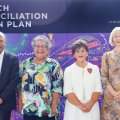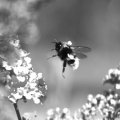After three months in the ice and snow researching volcanoes and the geological history of the Antarctic, University of Queensland PhD student Robyn Frankland has returned to studying the diamond deposits of northern Australia.
Ms Frankland, who is close to completing her PhD project on the evolution of the lithosphere in northern Australia, joined University Earth Sciences Department head Professor Ken Collerson in a field trip to the Antarctic in January.
Their aim was chiefly to confirm whether Australia has a second active volcano, with rock samples collected on Heard Island currently being analysed in the Department's state-of-the-art Radiogenic Isotope Laboratory.
These analyses will lead to a better understanding of the geological history of the southern icy continent and sub-Antarctic islands.
Research was carried out at three locations - Gaussberg, an isolated volcano on the Antarctic coast, Mt Brown at an elevation of 2000 metres 150km inland from Gaussberg, and Big Ben on Heard Island, until recently believed to be Australia's only active volcano.
Since 1936, Australia has claimed 42 percent of Antarctica and controlled the sub-Antarctic territories of Heard Island and the McDonald islands.
Valuable geological data were also gathered on Gaussberg - a 400-metre-high volcano located on the edge of the continent between the Antarctic stations of Mirny and Davis at 67 degrees south, 89 degrees east.
To reach the area, the research group travelled by ice-breaker to Davis Station 450km to the west and was then flown to the volcano in two long-range helicopters packed with 2000kgs of equipment.
The Gaussberg has a similar composition to rocks containing diamond in the Kimberley region of Western Australia, providing a direct link to Ms Frankland's thesis topic.
'What I am doing in northern Australia is along the same lines as the research carried out by Professor Collerson in the Antarctic,' Ms Frankland said.
'The aim was to collect samples to determine the age and isotopic composition of Gaussberg, which will give insight into the crust and mantle structure underlying Antarctica and a better understanding of the evolution of the continent.'
Ms Frankland's said her PhD project was also 'geochemically-oriented.'
'It represents a combined study into the characterisation of the lithosphere of northern Australia, the occurrence of anomalous diamond across northern Australia, and implications for the Australian Precambrian crustal evolution,' she said.
'It is of particular relevance to the mineral industry, especially in terms of diamond exploration, which depends on the location of accurately-dated cratonic regions and a definition of the extent of adjacent Proterozoic mobile belts.'
Ms Frankland has spent four years researching her thesis at the same time as undertaking a heavy schedule of lecturing and tutoring at the University in all geology related subjects.
For more information contact Robyn Frankland (telephone 3365 4787)



